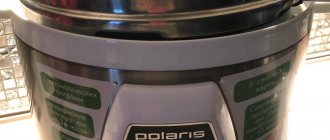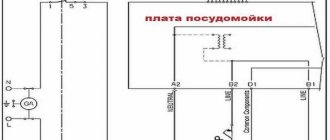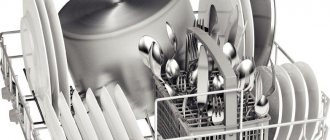Dishwashers have become a real godsend for modern housewives who want to spend more time in the evenings with their family and loved ones. In addition, these simple devices save water and electricity, which is very profitable considering utility prices. How long does it take for a dishwasher to clean? Everything directly depends on the cycle, but in any case, it will do it much faster and better, especially when it comes to washing cutlery after family feasts. Remember how many different types of dishes are usually left behind after gatherings; as a result, the housewife has to wash them under the cover of darkness, when all family members have long been asleep. Now you can simply load all the dishes into the tray and turn on the device, which will wash the most dirty plates and pots to a shine.
Factors that affect wash time
In the process of washing dishes in such a device, the same steps are repeated as in manual washing. If the dishes are very dirty, you need to soak them first. And then you can begin the main stage of washing, rinsing and drying. The duration of each stage is different. It depends on the type of washing program activated. It is worth noting that at high water temperatures the process takes longer. As a result, the duration of a full dishwashing cycle in such a device ranges from 30 minutes to two hours.
Main factors:
- When soaking. If the dishes are heavily soiled or have old food residues on them, then it is better to turn on the soaking program. This procedure will take approximately 19 minutes.
- When washing. After the soaking stage has ended, the dishwashing function starts, which has the following stages of operation:
- after collecting the required volume of water, the function of heating it to a certain temperature is turned on, and then the dishwashing process begins;
- then the machine starts using detergent;
- after combining water and detergent, the resulting liquid enters the sprayers, which are located below and above the machine;
- the sprayers begin to spin at high speed and, under pressure, supply hot water to the dishes located on the shelves;
- upon completion of the main stage, the contaminated water is drained and the rinsing process begins.
The wash lasts approximately 24 minutes. If there is a malfunction in the heating device, the dishwasher simply will not start.
- When rinsing. It is necessary to rinse the dishes to completely rid them of any remaining cleaning agent. The rinse lasts approximately 18 minutes. This is where the use of rinse aid begins. At this stage, the water no longer heats up.
- When drying. Most dishwasher models are equipped with a drying program. It will take about 20 minutes to dry the dishes thoroughly. Machines often use a conditioned type of drying. Expensive models have a built-in turbo dryer, where wet objects are blown with hot air.
Overview of dishwasher operating modes:
- Rinse mode.
The main function of this mode is to quickly wash dishes without the use of special cleaning agents. This washing mode is mainly chosen when it is necessary to refresh dishes that are clean but have not been used for some time.
- If there are dried food residues on the dishes, the dishwasher will not be able to clean them effectively without first soaking them. The pre-soak mode is one of the most important among all the available operating modes of this kitchen device.
It is important to know that all models of dishwashers will effectively wash dishes if there are remains of fresh food on them. If the dishwasher is not equipped with such a mode, then you will have to wash the dishes either immediately after eating, or soak them in the sink in order to wash them later without problems.
And if there are remains of burnt food on the dishes, then most machines will not wash the dishes without first soaking them, even when operating in intensive washing mode.
- Half load mode. This mode is economical, but it has much worse efficiency than the standard dishwashing mode. The washing principle in this mode is as follows. Of the two available baskets, only one is washable. This makes it possible to halve the consumption of water and detergent. It is worth noting that only full-size dishwashers equipped with two baskets have this mode.
How long does it take to wash PMM?
It all depends on the selected mode. The program may include the following stages:
- Submerge.
- Pre-rinse.
- Main wash.
- Rinse with conditioner.
- Drying (if available).
If you are loading dishes with dried food residue, select Soak or Pre-Rinse. But then the time will increase by 15-20 minutes. The instructions for most models contain tables or diagrams with recommendations on which mode to choose depending on the contamination.
The heating temperature also affects the time. Did you choose a program with a temperature of 70 degrees? The water heating time may increase by 15-20 minutes.
On short cycles, the plates may not dry, and if you set the standard mode, drying will take the same amount of time as soaking.
Typically, dishwasher cleaning time ranges from 30 to 180 minutes. It is necessary to take into account the brand and model of the PMM.
Consider the duration of the programs that can be found in each dishwasher. Basic washing modes that no user can do without:
- Intensive. Suitable for very dirty equipment. The jets are supplied under high pressure at a temperature of 70°C. How long does a cycle last? 1 hour. At the beginning and at the end, rinsing begins, then the main wash with the removal of detergents, drying.
- Ordinary. A final rinse will help clean the dishes - jets of water at a temperature of 65°C. The drying process ends. Duration - 1.4 hours.
- Fast. For light dirt. Wash at 35°C for only 30 minutes.
- Eco (economic). This is expected to help conserve resources. Its duration is 2 hours at 50 degrees. First, the instruments are rinsed, then washed, then rinsed twice and dried. The shortened version of Vario Speed lasts minutes.
Dishwashers often have additional features:
- Car. Automatic program selection. The PMM independently determines the load level, the amount of detergent and the cycle time. Average duration of minutes at 45-65°C.
- Delicate. Suitable for products made of fragile materials (crystal, glass, porcelain). Pass at 45°C for 110 minutes.
- Eat, run, run. If you loaded the dishes immediately after dinner, the master will clean them at a temperature of 65°C in 30 minutes. During this time, the equipment is washed, rinsed and dried.
See table:
Reduce your water and electricity consumption by 30% with the Half Load feature. This doesn't affect the time, but if you don't have a lot of dirty dishes, it saves resources.
But the Varlo Speed (Time Saving) function in Bosch dishwashers from Siemens works exactly the opposite. The time is reduced by 20-50%, but the energy consumption for a short wash is significantly higher.
What is the duration of the modes for different equipment manufacturers? Let's see.
| Model | Washing (in minutes) | |||||
| Fast | Intensive | Main | Economic | Delicate | Express 60 | |
| ELECTROLUX ESF 9451 LOW | thirty | 65-75 | 100-110 | 120-130 | ||
| HANSA ZWM 4677 IEH | 40 | 130 | 155 | 165 | 110 | 60 |
| Gorenje GS52214W(X) | 40 | 130 | 155 | 165 | 110 |
As you can see, the timing of programs from different manufacturers is almost the same. The instructions on the last pages indicate the parameters of the main modes: speed, water and electricity consumption.
Main stages of the program implementation
Modern dishwashers have quite a few programs and wash cycles. Most often, their number ranges from 12 to 15 programs. All programs are different from each other, but there is also something in common between them, such as the main stages of implementation:
- pre-washing is one of the important stages of the program, during which food residues are washed away;
- main wash. At this stage, the water can heat up to 70 degrees. It has the longest cleaning period. This is where detergent powder and tablets are used;
- rinsing. At this stage, the dishes are rinsed intensively to completely clean the utensils;
- drying is the final stage of the program.
After all these steps, the dishwasher is finished.
Examples
Using the example of various dishwashers, it will be possible to set the washing duration in different modes.
ELECTROLUX ESF 9451 LOW
- In quick wash mode, the duration of the procedure at a water temperature of 60 degrees is 32 minutes.
- Intensive washing involves heating the water to 70 degrees. Cycle time is approximately 36 minutes.
- In the main operating rhythm, the machine completes all procedures in 105 minutes.
- The economical program requires 125 minutes of work.
AEG OKO FAVORIT 5270i
- A quick wash lasts 32 minutes.
- In the intensive wash program, the machine runs for 105 minutes.
- The main program continues to run for 98 minutes.
- The bioprogram ends after 97 minutes.
HANSA ZWM 4677 IEH
- A quick wash lasts 42 minutes.
- Express 60 lasts one hour.
- Gentle care requires spending 108 minutes.
- ECO mode lasts 162 minutes.
- Dishes in normal mode become clean in 154 minutes.
- Intensive mode ends after 128 minutes.
Gorenje GS52214W(X)
- A standard wash lasts 154 minutes.
- The duration of intensive work is 128 minutes.
- The delicate program does its job in 108 minutes.
- Economical cleaning lasts 166 minutes.
- Fast wash lasts 43 minutes.
- With hot rinse the job lasts 62 minutes.
- The cold rinse mode continues to operate for 9 minutes.
Resource consumption per washing cycle
One of the important issues that concerns consumers is the consumption of resources, namely water, during one washing cycle. Can you really save money? To answer this question with confidence and accuracy, you need to study the characteristics of the selected dishwasher. Basically, in the instructions, the manufacturer indicates the average consumption for one washing cycle, but if you try, you can find information about what the consumption will be for a certain cycle.
On average, water consumption ranges from 10 to 13 liters completely per cycle. When washing dishes by hand, water consumption is much higher, since the tap does not close when washing utensils. It turns out that 50% of the resource is wasted just like that.
In dishwashing equipment, the water is not drained until the end of its operation, but is only filtered and returned clean to the top to begin rinsing the dishes.
Another issue that worries consumers is energy consumption. Modern models of dishwashers, as already noted, consume up to 13 liters per cycle. In this case, the electricity consumption is 1 kW per hour. It is quite economical.
The variable wash program provides for simultaneous washing of dishes using intensive mode and soaking. These processes are performed in different baskets. The use of the specified dishwashing program makes it possible to save approximately 25% of water, while maintaining good washing quality.
Saving water and electricity
The characteristics of dishwashers in saving water are also important. If manual washing consumes about 70 liters, then a machine will use only 10 for a similar set of dirty appliances. In terms of electricity consumption, it is not easy to compare. The device heats the water, but energy costs largely depend on its temperature at the time of filling. On average, 0.78 kW/h is consumed. Naturally, when washing by hand, no electricity is needed. But at the same time, it would be preferable to turn on additional lighting in order to wash more thoroughly.
Before purchasing such a machine, you should check the dimensions of the proposed device and how long the dishwasher takes to clean. Large devices are more profitable per set, but if you take into account frequent incomplete loading, this will significantly increase the cost of washing. Even if you set the partial load mode, only 40% less water will be used, and there is no point in washing particularly dirty pots in this mode.
If you study the instructions for proper loading, this will allow you to wash the maximum amount of dishes at one time and get clean plates, without streaks or dried-on food. You should not deny yourself the purchase of such a machine. It will not only free up extra time, but will also save your nerves and allow you to pay more attention to your family or favorite activities. Taking into account all costs, a dishwasher can pay for itself in about 4-5 years.
The final stage of machine operation
At the final stage of operation of the dishwasher, the used water is discharged into the sewer pipes. Then the stage of drying the dishes begins. Upon completion, the machine, as a rule, emits a signal and completes its work.
On the existing control panel there are indicators indicating the end of the program. After the machine has completely stopped, you need to turn it off. Experts recommend waiting about 15 minutes before starting to remove the dishes. This is because the dishes may still be hot after drying. Can open the door slightly to help the appliances cool down faster.
Is it harmful to the dishwasher if you run it frequently?
According to experts, the number of dishwasher cycles per week in the average household is about five. Do you want your car to serve you longer? Reduce this number if you can.
In a typical home, the dishwasher runs five times a week. Based on this average, those who use their appliance less than five times are likely to be less likely to repair and replace their dishwasher than those who use it six or more times.
A typical dishwasher has a lifespan of about 10 years, but if you run more than five cycles a week, you may need to replace yours after seven years or so. If you can reduce your cycles to fewer than five per week, your dishwasher could last 12 years or more.
So here's the bottom line: While running the dishwasher once a day, every day of the week may not be the best option for dishwasher longevity, it will likely save more water than if you wash dishes every day the traditional way. The question is which issue has higher priority, and that is up to you.
How to load dishes correctly?
Before loading the dishwasher, you need to do a few simple operations that precede the start of the washing process. This must be done to ensure that the machine lasts as long as possible and remains clean.
First, you need to remove as much food as possible from the plates, since large particles can get into the filter and clog it. This will lead to a decrease in washing efficiency, and in the future may cause damage to the dishwasher. You should also soak pots and pans if they have burnt or dried-on food residue.
A large number of dishwasher models are equipped with a special soaking or pre-wash program.
To begin with, heavily soiled dishes should be placed in the basket located below, since it is in this compartment that the water jets have the greatest power. Pots, frying pans with lids, bowls, and components from kitchen appliances such as a food processor, meat grinder, and mixer are often placed in this basket. It is worth noting that lids and flat trays should be placed on the sides of the basket, but pots and deep bowls should be loaded in the center. In this case, they should be placed at an angle and always upside down. This is necessary to ensure free circulation and drainage of water.
Small items such as forks, spoons, knives, sharp parts of food processors should be placed in a specially built-in container.
The sharp parts of these kitchen items should point downwards.
Before starting the machine, you need to make sure that the loaded dishes will not interfere with the rotation of the water sprayers during operation.
Regarding plates, cups and other fragile, small items, they should be placed in the basket located at the top. There are models of dishwashers in which holders are specially installed to ensure the stability of glasses and cups when washing them. It is forbidden to place deep containers inside each other, as the machine will not wash them.
Another important aspect of loading the machine is that the most dirty dishes should be placed in the basket, which is located in the lower part, and those that are less dirty should be placed in the upper part.
In the newest dishwasher models, the height of the basket at the top is adjustable. This makes it possible to wash dishes of different sizes in one cycle. It is important to choose the right washing temperature. The loading volume of the machine at one time directly depends on the dimensions of the unit. There are manufacturers whose instructions describe in great detail the process of loading dishes into the machine. Typically, these instructions come with such a kitchen unit.
Loading order
The quality of cleaning depends on the correct loading of devices into the working compartment.
You can use several baskets for different types of dishes and a special tray for spoons and forks. For proper placement, adjust the level of the basket so that the water flow hits all items. Start loading from the bottom tier. Besides:
- Place large dirty items in the lower basket, and small ones in the upper basket;
- Place large utensils closer to the edge, and smaller ones closer to the middle of the basket;
- place the tray with spoons, forks, knives in the center, place them with the handle down;
- install pans with handles only horizontally so that they do not hit the ceiling of the compartment;
- Place all containers upside down only, so the flow of water will completely wash away the detergent;
- Place cups, glasses and glasses on the holders provided for this purpose.
Product benefits
Of course, for bachelors, buying miracle equipment may not be such a pressing issue, because there is a lot of advice on the Internet, including putting a disposable plastic bag on a plate. But for at least a small family, purchasing such a product is a real way out of the situation. In addition, a modern dishwasher can significantly save money on the use of water resources.
Consumption
What is the approximate consumption of a dishwasher? Of course, it will be slightly different depending on the brand, model and year of manufacture. But even outdated dishwashers are unlikely to consume more than 20 liters of water. Almost all manufacturers indicate in the technical characteristics of the product the main parameters of water consumption by washing equipment. It is divided, depending on the dimensions, into full-size and narrow. These purchase criteria show how many dishes a particular machine can hold, and how many items it can thoroughly wash in one wash.
13 – 14 regular sets of dishes can bring a full-sized product to shine. The maximum water consumption will not exceed 15 liters. Compact size machines (narrow) capable of processing from 6 to 9 sets. In this case, the equipment will take no more than 10 liters of water from the water supply system.
Saving
And yet, does a dishwasher save our water? According to experiments and consumer reviews, when washing dishes by hand in an amount corresponding to 1 dishwasher load, hot water consumption reaches about 70 liters, and cold water consumes about 30. It turns out that modern household washing equipment can significantly reduce the water supply meter readings.
So how much water exactly does a dishwasher use? Here's an example:
Bosch SPV63M50 (compact) - loading up to 9 sets, consumption 8 l;
Siemens SN66M094 (regular) - loading up to 14 sets, consumption 10 l;
Smeg BLV2VE (full size) - 13 rooms, 8.5 l.
For a small family and pensioners, a compact model is quite enough, otherwise you will have to spend excess water on washing just a few plates and you won’t be able to save money. Or, as an option, long-term accumulation of dishes to fully load the machine. The leaders in terms of savings at this stage are European brands. It is these machines that should be given preference if the factor of saving water resources is significant for the consumer
Well-known brands such as Electrolux, Bosch, Siemens pay special attention not only to saving tap water, but also electricity
The models presented in the example are premium products. The average power consumption ranges from 0.7 to 0.9 kW, depending on the size of the equipment. Many modern models have a half-load function; its use allows you to save up to 30% of water. The undoubted leader, according to consumer reviews, constantly tops the list of the best dishwashers, is Bosch.
A couple of tips
The “half full” function of the equipment does not mean that in this case the use of water and electricity by this kitchen appliance will be at the optimal level. In most cases, the water consumption of a dishwasher is 60% of the usual amount. The situation is the same with electricity; in addition, overly dirty dishes may simply not be washed.
Systematic and intelligent stacking of dishes will allow you to fill the dishwasher as much as possible. This will make it possible not only to save water and electricity, but also to ensure perfectly clean dishes at the end. Usually, any product comes with instructions with detailed pictures and recommendations on how to lay out kitchen utensils.
It is necessary to take into account that a volumetric dishwasher is more profitable, based on the calculation of water consumption for one full load. But she will use water according to the program, regardless of the number of dirty dishes.
Eco
The eco mode is aimed at preserving the planet's limited resources and helps housewives save energy and water consumption when washing dishes.
The eco program of a Bosch car involves the following algorithm:
- Pre-rinse.
- The washing up.
- Rinsing at 65 degrees.
- Drying.
Examples
Using the example of various dishwashers, it will be possible to set the washing duration in different modes.
ELECTROLUX ESF 9451 LOW
- In quick wash mode, the duration of the procedure at a water temperature of 60 degrees is 32 minutes.
- Intensive washing involves heating the water to 70 degrees. Cycle time is approximately 36 minutes.
- In the main operating rhythm, the machine completes all procedures in 105 minutes.
- The economical program requires 125 minutes of work.
AEG OKO FAVORIT 5270i
- A quick wash lasts 32 minutes.
- In the intensive wash program, the machine runs for 105 minutes.
- The main program continues to run for 98 minutes.
- The bioprogram ends after 97 minutes.
HANSA ZWM 4677 IEH
- A quick wash lasts 42 minutes.
- Express 60 lasts one hour.
- Gentle care requires spending 108 minutes.
- ECO mode lasts 162 minutes.
- Dishes in normal mode become clean in 154 minutes.
- Intensive mode ends after 128 minutes.
How to choose the right kitchen sink, criteria and review of popular models
Gorenje GS52214W(X)
- A standard wash lasts 154 minutes.
- The duration of intensive work is 128 minutes.
- The delicate program does its job in 108 minutes.
- Economical cleaning lasts 166 minutes.
- Fast wash lasts 43 minutes.
- With hot rinse the job lasts 62 minutes.
- The cold rinse mode continues to operate for 9 minutes.











